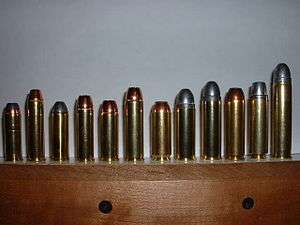.50 Alaskan
| .50 Alaskan | ||||||||||||||||
|---|---|---|---|---|---|---|---|---|---|---|---|---|---|---|---|---|
|
Left to Right (line by line) .44 Magnum, .445 Super Magnum, .45 Colt, .454 Casull, .480 Ruger, .475 Maximum, .50 Action Express, .500 Linebaugh, .500 Maximum, .500 S&W Magnum, .50 Beowulf, .50 Alaskan | ||||||||||||||||
| Type | Rifle, Large game | |||||||||||||||
| Place of origin | United States | |||||||||||||||
| Production history | ||||||||||||||||
| Designer | Harold Johnson | |||||||||||||||
| Designed | 1950s | |||||||||||||||
| Specifications | ||||||||||||||||
| Parent case | .348 Winchester | |||||||||||||||
| Case type | Rimmed | |||||||||||||||
| Bullet diameter | .510 in (13.0 mm) | |||||||||||||||
| Neck diameter | .536 in (13.6 mm) | |||||||||||||||
| Base diameter | .553 in (14.0 mm) | |||||||||||||||
| Rim diameter | .610 in (15.5 mm) | |||||||||||||||
| Rim thickness | .070 in (1.8 mm) | |||||||||||||||
| Case length | 2.10 in (53 mm) | |||||||||||||||
| Ballistic performance | ||||||||||||||||
| ||||||||||||||||
| Source(s): Hodgdon[1] | ||||||||||||||||
The .50 Alaskan is a wildcat cartridge developed by Harold Johnson and Harold Fuller of the Kenai Peninsula of Alaska in the 1950s. Johnson based the cartridge on the .348 Winchester in order to create a rifle capable of handling the large bears in Alaska.
Design
Harold Johnson necked out the .348 Winchester case to accept a .510" diameter bullet,[2] and Harold Fuller developed the barrel, marrying a .50 caliber barrel to an old Winchester Model 1886 rifle.
Since the rifle was designed for use on Alaska’s great bears, Johnson cut 720-grain (47 g) boat-tail .50 BMG bullets in half, seating the 450-grain (29 g) rear half upside down in the fireformed .50-caliber case. It didn’t take Johnson long to find out that the 450-grain truncated shaped "solid" would shoot through a big brown bear from any direction, claiming in 1988, "I never recovered a slug from a bear or moose, no matter what angle the animal was shot at."
Performance
Harold’s favorite load in the .50 Alaskan was 51.5 grains (3.34 g) of IMR-4198 with a Barnes 400-grain (26 g) flatnose, jacketed bullet for about 2,100 ft/s (640 m/s) and just under 4,000 ft·lbf (5,400 J)of muzzle energy..
The Alaskan is shorter than the .510 Kodiak Express and produces about 10% less energy or 33% less energy than the 50-110, out of a 71 Winchester re-barreled to chamber the 50-110 WCF 6,000 foot-pounds.[3]
Availability
Rifles for .50 BMF Bullet are available from some specialty gunsmiths and also conversions from Marlin and Winchester lever-action rifles.[4][5][6] Reloading dies are available from Hornady.[7] Although it is considered a wildcat cartridge, loaded ammunition is available from Buffalo Bore.[8][9]
See also
References
- ↑ The .50 Alaskan Built on a Marlin Levergun by Al Anderson
- ↑ Taffin, John (March 2004). "Big Bore Hunting Rifles". Guns Magazine. Archived from the original on 28 November 2010. Retrieved 25 September 2010.
- ↑ McPherson, M.L. (November 2008). "The .510 Kodiak Express the 5,000 foot-pound Marlin". Guns Magazine. Retrieved 25 September 2010.
- ↑ Taylor, Jim. "The Model 71 Winchester and the .348 WCF Cartridge". Leverguns.com. Archived from the original on 7 October 2010. Retrieved 25 September 2010.
- ↑ "Available conversions".
- ↑ Cassell, Jay (2009). Shooter's Bible: The World's Bestselling Firearms Reference. Skyhorse Publishing. p. 235.
- ↑ ".50 Alaskan 3 Die set".
- ↑ ".50 Alaskan Ammunition".
- ↑ Taffin, John (March 2004). "Serious ammunition: heavy duty factory loads for the big-bore levergun". Guns Magazine. Retrieved 25 September 2010.
